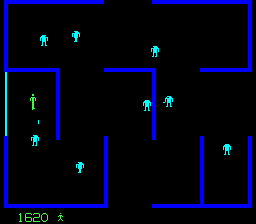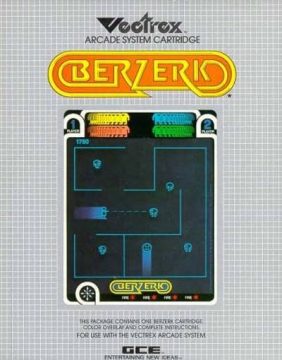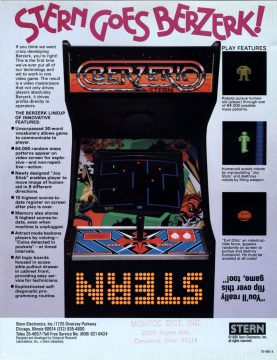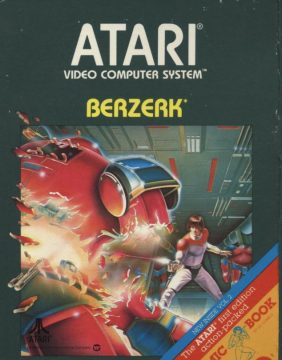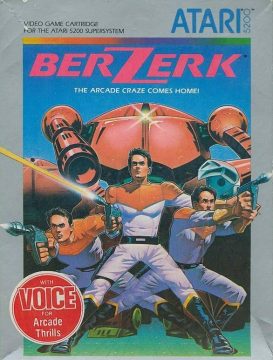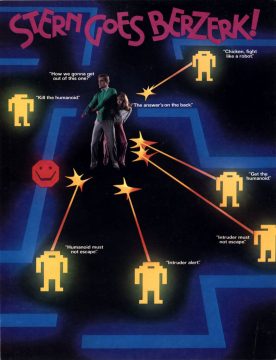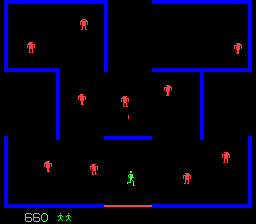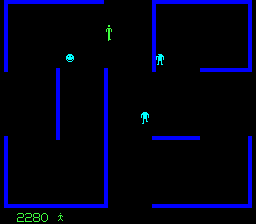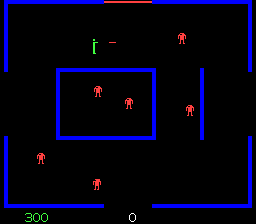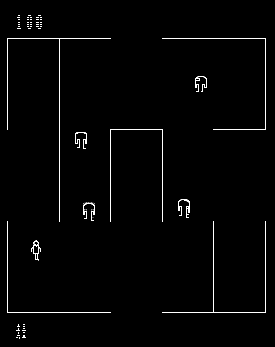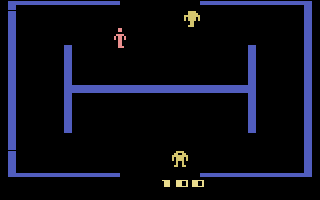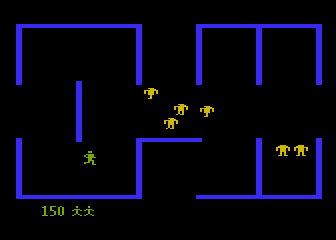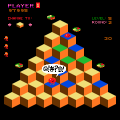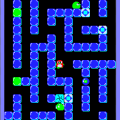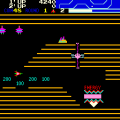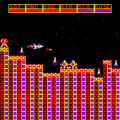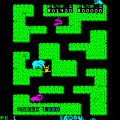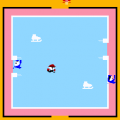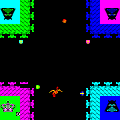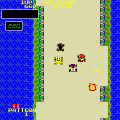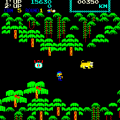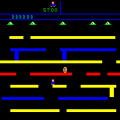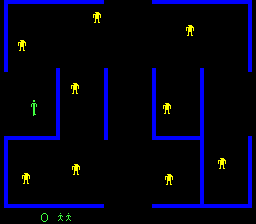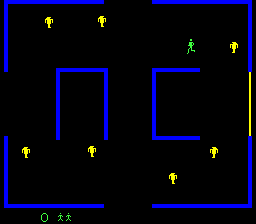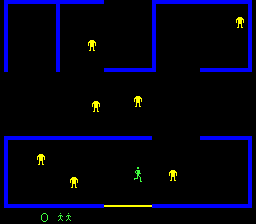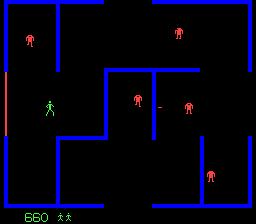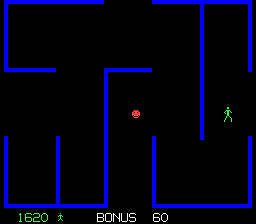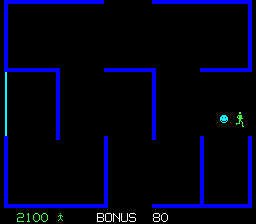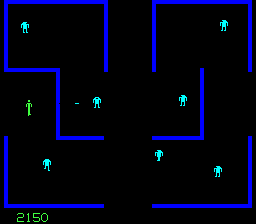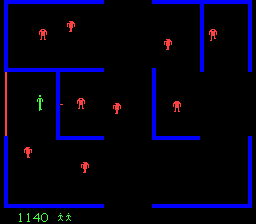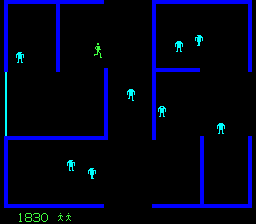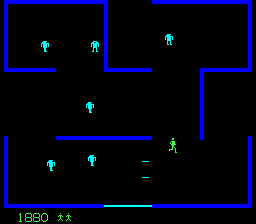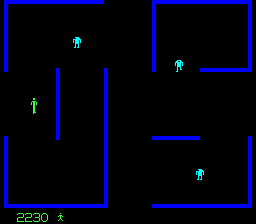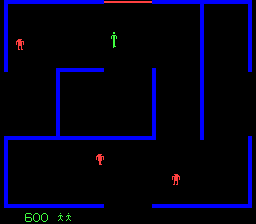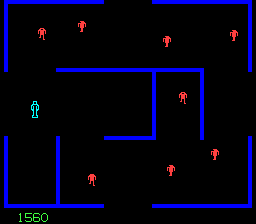- Berzerk
The NES era saw video games become more complex and larger in scope, but it also meant the beginning of the loss of the simplicity and minimalism that were omnipresent in early arcade games. These days, some people are far too quick to dismiss those excessively basic games as being nothing more than the product of their technological limitations, but arcade gaming is a separate genre with its own inherent merits. Instead of focusing on what longer and feature-rich games can do that arcade games cannot, keep in mind that this style also has many unique qualities that just aren’t achievable with more complex games. The greatest benefit to this style comes from its directness – removing everything other than the bare essentials concentrates the already white-knuckle, frantic gameplay that most of them possess to create a level of intensity that you just don’t find elsewhere. Robotron 2084 still remains the greatest testament to this sensibility, but the next best example arguably comes in the form of a series of two arcade games from the early 1980s called Berzerk and Frenzy.
Both Berzerk and Frenzy fall squarely into the arena shooter genre, but they’re best defined by their insanely intense action. In each game, you control a stick figure, of which lacks any name or characterization. Whether intentional or otherwise, the style of the character actually works in favor of the extremely minimalist design of the game.
The objective in each game is to move through an endless series of rooms shooting robots that can also shoot back at you. Your only real goal is to survive, but your only reward is scoring points which you accomplish through destroying enemy robots. In each game the rooms are comprised of walls arranged in a maze-like formation with exits to the middle of all four sides of the screen. Both the arrangement of the maze and the placement of enemies is randomly generated. Both games also have identical, and very simplistic, controls. You move your character with a joystick, and fire in whichever direction you are facing by pushing a lone button. As opposed to Robotron or Smash TV, you don’t have independent eight way shooting, you can’t fire while moving, and you can’t have a multitude of your own shots on screen at once.
Each game in the series is also EXTREMELY difficult. Most rooms begin with an almost overwhelming amount of foes, but it’s never so much that you can’t blast your way through it all and run like hell to the nearest door. Your stick-man moves at a pace that’s just fast enough to keep the controls perfectly intuitive and effective, but never fast enough to make it too difficult to dodge shots. The speed at which lasers move is much faster than your walking speed, but it’s generally possible to get out of the way if you’re paying attention.
So as ludicrously, overwhelmingly difficult as they are, both games are designed so that they’re still fair – at least at first. Like most early arcade games, both Berzerk and Frenzy quickly rise to the point of being impossible. Each room is more difficult than the last, and the difficulty level skyrockets VERY quickly. That’s part of why its mechanical and structural simplicity is so important – you need to be able to react as quickly as possible to what is going on in that exact instant. If the game were any more complex, it would only serve as a distraction. The simplicity of the mechanics is absolutely essential – if you had anything else to consider other than blasting your way through robots then you’d have no chance. Don’t let the games’ difficulty discourage you from playing because the challenge is part of their appeal. They’re both designed in a way so that their difficulty works in favor of the gameplay, and you’ll find very few games that begin to compare to the level of intensity of Berzerk and Frenzy.
What the series is most associated with is a strange villain – a bouncing smiling face named Evil Otto. What makes him so memorable isn’t merely that he’s so bizarre; it’s also how he’s applied within the games. He actually only shows himself if you’ve stayed in a room for several seconds, but when he does you’re in serious trouble. He can’t fire any shots like the other robots but he relentlessly chases after your character and is completely invulnerable in Berzerk. What makes him most difficult to deal with is that he can move through walls without slowing down, giving him the ability to catch up with you quickly.
Of course, if you always leave each room as quickly as possible then you’ll never even see Evil Otto. However, that factor is why he’s so important to the gameplay – the ever present threat that he imposes completely defines how you have to play the game. You are forced to barrel through the game and deal with every threat the instant that it presents itself. Hesitation means having to deal with Evil Otto. The fact that enemy placement and maze arrangements are both randomly generated means that simply memorizing levels or enemy patterns isn’t an option. You have to adapt on the fly to everything that the game throws at you. As a result, the games are always keeping you in the moment. That’s why Evil Otto is so important – the ever present threat that he poses takes what is already nerve wracking action and magnifies it to where it ranks among the most frenetic gameplay in any video game ever. No villain in video games has ever had a greater effect on gameplay than Evil Otto – he completely changes the mood of the game when he’s on screen, and you’ll find yourself absolutely dreading his appearance before he shows up.
There are really only a few advanced strategies or techniques to the series, and all can be applied to both games. There’s a trick that allows you to fake Robotron-style controls from a stand still – if you hold down the fire button then you’ll shoot in whichever direction you push the joystick. You can also stop enemy lasers by shooting them with your own. There’s also an advanced technique that potentially allows players to avoid shots if they can’t get out of the way quick enough. The only thing differentiating your character from a conventional stick figure is that its head is not actually attached to its torso. If you can get a laser to move through the VERY small neck-gap then it will pass through without doing any damage at all. A word of advice: don’t EVER rely on this technique – you’ll almost definitely get obliterated if you ever attempt it when there’s another way to avoid fire. A good way to maximize your score is to always move from left to right. Evil Otto always begins at the left of the room, so this technique assures that you’ll be as far away from him as possible, while still allowing you to do a full sweep of the room. It will also keep most enemies above and below your character, which is beneficial because he’s taller than he is wide, so he’ll present a smaller target.
Berzerk was developed by Stern in 1980. Its designer, Alan McNeil, based the game on a dream he had about a game with a similar premise, and derived the game’s title from Fred Saberhagen’s Berserker series of science fiction novels. Evil Otto was named after a fellow Stern employee that was disliked by McNeil. Berzerk‘s mazes are made up of electrified walls, and in each room there are several robots that look like bulkier versions of your character. You will be killed if you make contact with either a laser, a robot (even if they are in their exploding animation), or a wall. Two people can play Berzerk, with the game alternating between Player 1 and Player 2.
Technically, you can sort of beat Berzerk – it will crash if you make it through 64000 rooms. Obviously, this is probably beyond human capability. Given that the game doesn’t reward players with anything other than points, the scoring system is a very important part of Berzerk. You get fifty points for every robot destroyed, and an extra 10x as many points as there were robots in room if each is destroyed. Your score also has effects on exactly how the difficulty in the game progresses. Robots will change color as the game progresses, getting more difficult as they do. They also gain the ability to have more shots on screen at once, but the limit applies to the group as a whole. There are actually two slightly different releases of the arcade machine, but they only differentiate in how the difficulty progression works.
In the first, and much rarer, version of the machine, the robots are yellow and can’t fire. Then they become red and are limited to a lone laser on screen for the entire group. After this they become white and can have two lasers on screen at once, which applies for the remainder of the game. Evil Otto moves at about half your walking speed when there are still robots left in the room, and equal to your walking speed after every robot is destroyed. After you score 5000 points he will begin to move twice as fast (equal to your character’s speed when there are still robots in the room, and twice as fast after they are all destroyed). In the second version, which is what made it to most arcades, things were made even more difficult. Robots can also become purple, green, and, light blue, and their laser limit will go up with each change. After they reach five lasers on screen at once their limit will reset, but their lasers will move faster. Their limit will then begin to go up again as you score more points, but with these faster lasers – it peaks at seven fast lasers. In each version you begin with three lives, which isn’t going to last very long. Luckily, you’ll be rewarded an extra life for every 5000 or 10000 points, depending on which of the two that the machine is set for.
Another memorable aspect of Berzerk is that every robot in the game is extremely stupid. Not only will they shoot each other, but they’ll also actually walk straight into walls, each other, and Evil Otto, and generally make it as relatively easy as possible for you to dispense with them. This actually works in the game’s favor by balancing out the indestructibility of Evil Otto and the game’s difficulty level. You’ll have extremely difficult time dealing with things as it is, so there’s no way you’d destroy every robot, or even make your way out of a room, before Evil Otto shows himself if robots were smart. What’s more is that you’ll get an identical amount of points whenever a robot is destroyed, whether or not you’re responsible for destroying them. So the easiest way to play the game well is to learn to exploit robots’ stupidity whenever possible to get them to destroy themselves.
Other than Evil Otto, what Berzerk is generally most remembered for is containing digitized speech samples. The game contains thirty words in all – an astonishing total for a video game in 1980 – and there were even non-English language versions produced. Other than the random robot dialogue that’s played throughout the game, there are also five complete phrases. The most memorable bit of speech in the entire game by far is “Intruder alert! Intruder alert!”, which is played whenever Evil Otto enters an arena. No other audio recording has ever signified impending doom quite as well, so it’s definitely among the most memorable quotes ever in video games.
In this day and age, people might take a look at a game like Berzerk and dismiss it outright, due to its extreme visual simplicity. Besides the sprite for Evil Otto, Berzerk‘s sprite art consists of nothing more than stick figures for characters, and walls that look like they were made in MS Paint in five seconds – both set against a completely empty background. It’s easy to see why people would overlook these kinds of designs, but this simplicity, combined with a very distinct color palette, makes for a game that doesn’t really look exactly like any other. So, what really makes Berzerk so fantastic looking isn’t even the appeal of minimalism, it’s that this all gives the game a visual identity. Berzerk is instantly recognizable from any screenshot. How many games can that be said about?
Berzerk proved to be Stern’s biggest hit, and was given a trio of ports. The Vectrex version plays sluggishly, and completely fails to recreate the feel of the arcade game. A version was also made for Atari 2600 that’s vastly simplified, but plays fairly well and is about as faithful to the arcade version as could realistically be expected, and it even replicates that “bulletproof neck-gap” trick. This release is also differentiated from the original by the fact that Evil Otto can be temporarily destroyed, at least in certain game modes. The best port by far is the version developed for Atari 5200, which may be one of the best games for the platform. Not only does it do relatively well at recreating the feel of the arcade release, but it even has the digitized speech, which is pretty jarring to hear coming from an Atari 5200.
Links:
StategyWiki – Berzerk Breakdowns of the different versions.
